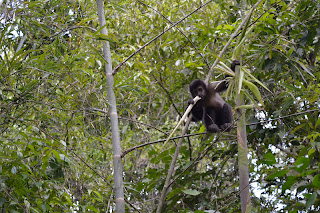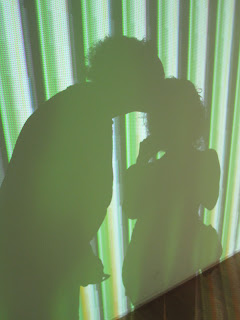“Boing, boing, BOING, BOI-ING.” The sound reverberated through the dense rainforest.
“What the hell is that?” I asked Dan, scanning the trees. Through the twisting vines, we could just
make out a black Capuchin monkey, perched on a branch, smacking something iridescent
green against the wood. A creature, arms outstretched, fingers splayed, as if
signalling for help. “Oh Jesus,” I gasped, “It’s a monkey killing a frog!”
 |
| This is not the culprit - but one of his friends |
We watched, horrified,
transfixed. The fiendish monkey was relentless, pounding the frog until it
boing-ed no more. Then he stuffed the reptile into his mouth, ripped out its
innards with his teeth, and feasted. I looked away. We’d come to see waterfalls
- but the subtropical rainforest of Iguazu National Park was dishing up a whole
lot more wildlife than we bargained for.
Huge ants and spiders, exotic birds, raccoon-like coatis badgering
tourists – it teemed with life.
 |
| Huge ant |
Earlier that morning, on a hiking
trail, we’d heard a rumbling, throaty cough reverberate around the jungle,
inches from our path. Branches cracked. Birds fled in every direction. Dan and
I stopped dead and stared at each other. In my hand, I was holding a pamphlet
we’d been given on arrival, a picture of
a jaguar leering from it, warning what to do if we encountered a Big Cat. “Keep
calm. DO NOT RUN (their instinct is to chase)” it read. We did not run, but we
walked away extremely quickly. Definitely a jaguar. Definitely.
But whatever unexpected wildlife
we encountered at Iguazu, nothing compared to the falls themselves. The first
sight, even from a distance, actually made me gasp. The setting was like something
conjured up by the cinematographers of Disney’s “Up.” An impossibly beautiful
panorama of jagged cliffs topped by lush jungle, broken by a series of
thundering falls and dozens of smaller streams cascading like silver ribbons
into the wide river below. The image was framed by tall palm trees, bromeliads
and orchids, with circling hawks casting shadows on the forest below. Unforgettable.
The local Guarani people called
it as they saw it – Iguazu means “Big Water”, with 275 falls within 2.5
kilometres. It’s hard to comprehend until you get there, but the falls were
enough to entrance us for two full days. Each angle provided a totally
different experience. The panoramic views on the Brazilian side were magic, but
the real buzz was on the Argentinian side, where you could get up close, let
the powerful spray jab your face like needles, and hear the falls roar as they
slammed into rocks far below. We lost
half an hour trying to trace individual beads of water as they fell over the
top like molten silver, and plunged to the bottom. My favourite vista was from
the upper walkway, where the falls slid away beneath your feet.
We cruised out in a speedboat for
the must-do drenching, where we were enveloped in torrents of water. Feeling
the falls pounding down on your head was a unique way to appreciate their power.
The best moment though, was
reaching the “Garganta del Diablo” – the Devil’s Throat – at the end of the
day. We followed a long walkway out across the broad river for more than a
kilometre to the crescent-shaped falls, which are 700m long. The name couldn’t
be more apt – gallons of water are swallowed by an immense cavity, where the
force of the water hitting the bottom 80 metres below is so great the mist it
generates rises back to the top. It is one of the most phenomenal natural
sights I’ve ever seen, and we were there just in time to see a rainbow cast its
light across the cascades. If you haven’t been – put this on your must-do list.
Incredible.
A final thought goes out to
Aerolineas Argentina, the country’s much maligned national airline
(with a Skytrax rating of only 40%.). But I won’t have a bad word said about
them. Sure, we arrived at Puerto Iguazu
half an hour late – but that was because the pilot surprised us with a fly-over
of the falls. He completed a full circle – giving everyone on our side of the
plane an incredible first glimpse of what was to come. (Though Dan claims he
couldn’t see anything because my head was in the way as I took photos… woops…
sorry babe. Here they are for your enjoyment!)




















































